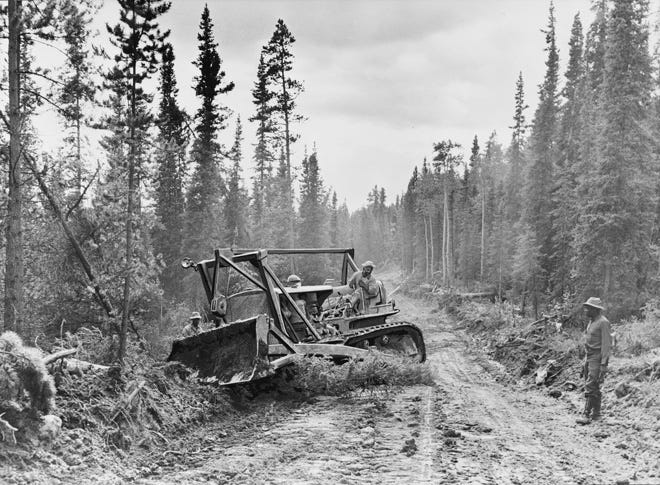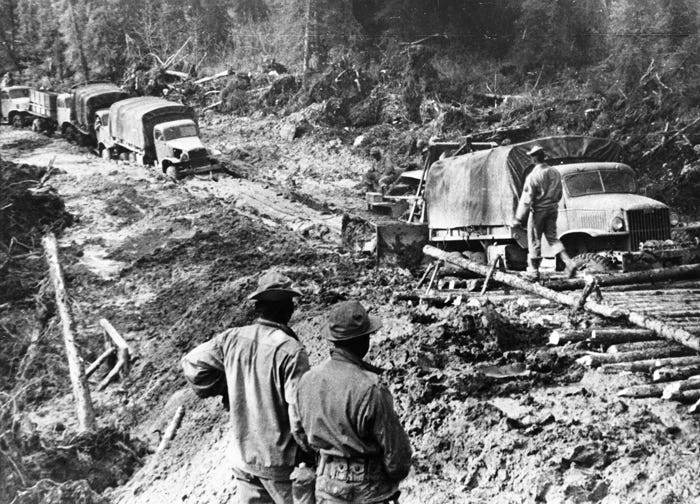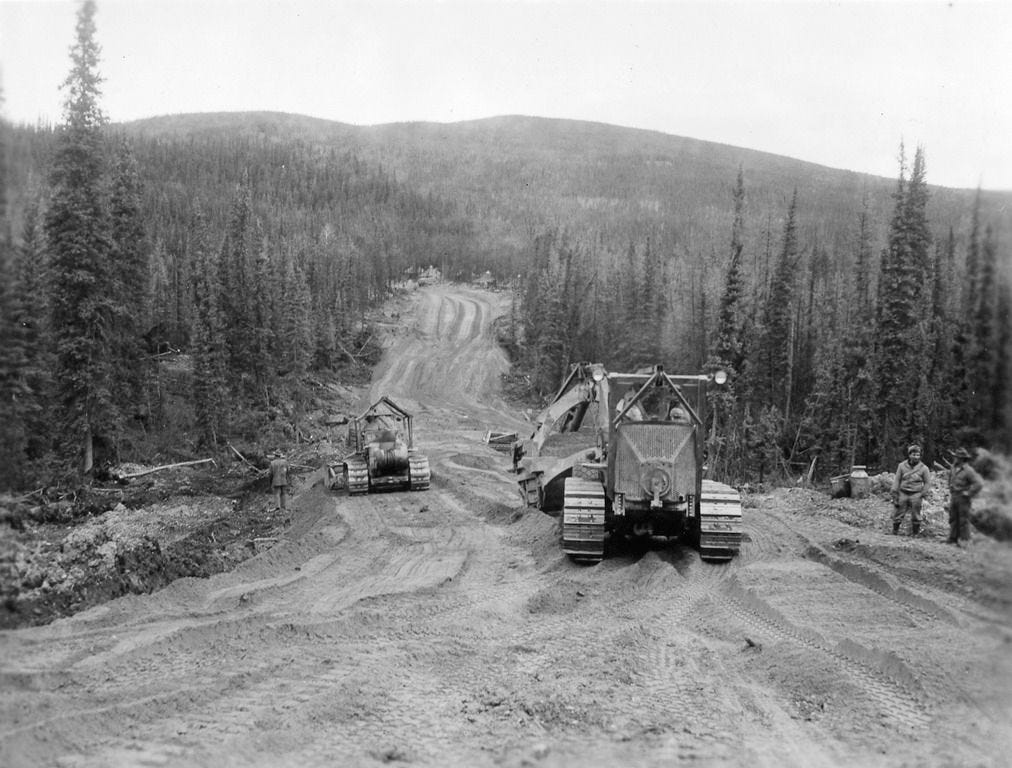October 29 - North America's New Artery: The Alaska Highway Completed
Embracing Imperfect Progress in Faith
This is the day the Alaska Highway (Alcan Highway) was completed in 1942.
In today's lesson, we will explore how God uses our imperfect efforts to accomplish His perfect will. How does the rushed construction of the Alaska Highway during World War II mirror our own spiritual journeys? What can we learn about faith, progress, and divine purpose from this remarkable feat of engineering?
"But he said to me, 'My grace is sufficient for you, for my power is made perfect in weakness.' Therefore I will boast all the more gladly about my weaknesses, so that Christ's power may rest on me." - 2 Corinthians 12:9 (NIV)
This Date in History
Two bulldozers met near Beaver Creek, Yukon Territory, on October 29, 1942. Their operators climbed down, shook hands, and in that moment, the impossible became reality. The Alaska Highway, a 1,700-mile engineering marvel spanning wilderness and connecting the continental United States to Alaska, was complete.
Behind this monumental achievement stood Donald MacDonald, an unassuming employee of the U.S. Department of the Interior. In the 1920s, MacDonald became consumed by a vision: a road stretching from the lower 48 states to Alaska. For nearly two decades, he tirelessly lobbied Congress, penned articles, and delivered impassioned speeches. Many dismissed his dream as folly, but MacDonald's unwavering dedication kept the idea alive against all odds.
MacDonald's persistence found an unexpected champion in Harold Ickes, the irascible Secretary of the Interior under President Franklin D. Roosevelt. Known for his acerbic wit and no-nonsense approach, Ickes saw beyond the immediate challenges. He recognized the highway's potential to unlock the resource-rich north and bolster continental defense. Ickes' political savvy and influence proved instrumental in advancing the project from pipe dream to possibility.
The Japanese attack on Pearl Harbor on December 7, 1941, catapulted the Alaska Highway from visionary concept to urgent military necessity. General Simon Bolivar Buckner Jr., commander of the Alaska Defense Command, emerged as a forceful advocate. Buckner, whose father had fought as a Confederate general in the Civil War, understood the strategic vulnerability of Alaska. He argued vehemently that the highway was crucial to protect against potential Japanese incursions in the north.
On March 8, 1942, construction began with a workforce as diverse as it was determined. Over 10,000 U.S. Army personnel and 16,000 civilians tackled the project. Among them were nearly 4,000 African-American soldiers, including the 93rd Engineer Regiment. These men, facing entrenched discrimination both in uniform and civilian life, often found themselves assigned the most challenging and dangerous sections of the route. Their contributions, long overlooked, were integral to the highway's completion.
Colonel William Hoge, the project's chief engineer, confronted the harsh northern terrain with innovative solutions. He controversially decided to use permafrost as a foundation for sections of the road. This approach, while expedient, would lead to ongoing maintenance challenges in the years to come, a testament to the project's rushed wartime origins.
As construction progressed, remarkable stories emerged from the wilderness. Private Refines Sims Jr. of the 97th Engineer Regiment became known as "The Barefoot Bulldozer Operator" after driving his machine for three days straight without boots, having lost them in the mud. His dedication exemplified the grit and determination that permeated the entire project.
The construction crews battled more than just terrain. Equipment failures were common, with one report noting that for every hour a bulldozer operated, it required one and a half hours of maintenance. Mosquitoes tormented workers relentlessly, with some men reportedly succumbing to anemia from excessive bites.
Despite these challenges, the highway took shape at an astonishing pace. Workers cleared millions of trees, moved mountains of earth, and constructed over 100 major bridges. At times, progress was measured in feet rather than miles, but the advance was relentless.
The highway's completion had immediate military implications. It facilitated the construction of airfields crucial to the Lend-Lease program, which supplied aircraft to the Soviet Union. Beyond its strategic value, the road opened vast regions of Canada and Alaska to economic development and tourism.
In the years following its wartime construction, the Alaska Highway underwent significant improvements. The original rugged trail was gradually widened, straightened, and paved. Today, it stands as a vital artery for commerce and a magnet for adventurers seeking to experience the rugged beauty of the North.
The Alaska Highway's construction remains a testament to international cooperation, human perseverance, and the transformative power of infrastructure. Its completion on October 29, 1942, marked not just the end of a construction project, but the dawn of a new era for North America, forever altering the continent's geography and geopolitics.
Historical Context
The completion of the Alaska Highway in 1942 coincided with a period of global conflict and shifting geopolitical priorities. The early 1940s saw the world engulfed in World War II, with the United States joining the Allied powers following the attack on Pearl Harbor in December 1941.
The war had dramatically altered the strategic importance of Alaska. Once considered a remote and barely developed territory, it suddenly became a potential frontline in the Pacific Theater. The Japanese occupation of the Aleutian Islands in June 1942 only heightened these concerns, underscoring the need for better transportation and supply lines to the region.
Internationally, the relationship between the United States and Canada was evolving. The Ogdensburg Agreement of 1940 had established the Permanent Joint Board on Defense, fostering closer military cooperation between the two nations. This collaboration paved the way for the joint effort required to construct the Alaska Highway, with Canada allowing the U.S. military to build on its soil.
The project also reflected the changing nature of warfare and military strategy. The concept of continental defense was gaining prominence, emphasizing the need for robust infrastructure to support military operations across vast distances. The Alaska Highway was seen as a crucial component of this new approach to national security.
Domestically, the United States was undergoing significant social and economic changes. The massive mobilization for war had pulled the country out of the Great Depression, but it had also exacerbated existing racial tensions. The use of segregated African-American units in the construction of the highway mirrored the broader issues of discrimination in the military and society at large.
Technologically, the 1940s saw rapid advancements in engineering and construction techniques. The Alaska Highway project both benefited from and contributed to these developments, as engineers and workers devised innovative solutions to overcome the challenges posed by the harsh northern environment.
The completion of the highway also occurred at a time when the American public's perception of Alaska was changing. Once viewed as a frozen wasteland, the territory was increasingly seen as a land of opportunity and natural beauty, a shift that would contribute to its eventual statehood in 1959.
In the broader context of North American development, the Alaska Highway represented a continuation of the continent's history of ambitious infrastructure projects, from the Transcontinental Railroad to the Panama Canal. Like these earlier endeavors, it would play a significant role in reshaping patterns of settlement, commerce, and geopolitical influence in the decades to come.
Did You Know?
During construction, 133 bridges and over 8,000 culverts were built, using 19,000 tons of steel.
Today’s Reflection
The Alaska Highway, hastily constructed in 1942, was far from perfect. Built with rudimentary tools and battling harsh conditions, the original road was rough, winding, and in many places, little more than a dirt track. Yet, this imperfect path became a lifeline during World War II and laid the foundation for the modern highway we know today.
This historical moment offers a profound spiritual lesson. How often do we find ourselves paralyzed by the fear of imperfection, waiting for the 'perfect' moment to act on God's calling? The Bible reminds us that God's power is made perfect in our weakness (2 Corinthians 12:9). Our Heavenly Father values the heart and intention behind our obedience more than the flawlessness of our actions.
Consider Moses, who protested his inadequacy as a speaker when God called him to lead the Israelites (Exodus 4:10-12). Despite his perceived imperfections, God used Moses mightily. Or think of David, a young shepherd boy chosen to be king, whose imperfect life became a testament to God's grace and power (1 Samuel 16:7).
The construction of the Alaska Highway teaches us that sometimes, the urgency of the mission outweighs the need for perfection. The engineers and workers didn't wait for ideal conditions or perfect plans; they forged ahead, knowing that an imperfect road was better than no road at all. In our spiritual lives, we often face similar situations. God calls us to act in faith, even when we feel unprepared or inadequate.
Jesus's own disciples were far from perfect. They misunderstood His teachings, doubted His power, and even denied knowing Him. Yet, these imperfect men became the foundation of the early church. Their 'rough draft' faith was refined through experience and the power of the Holy Spirit.
The Apostle Paul, reflecting on his own weaknesses, wrote, "But he said to me, 'My grace is sufficient for you, for my power is made perfect in weakness.' Therefore I will boast all the more gladly about my weaknesses, so that Christ's power may rest on me" (2 Corinthians 12:9).
Like the Alaska Highway, our spiritual journey is often a process of continuous improvement. We start with a rough path, full of twists and turns, but as we walk in faith and obedience, God smooths out the way. Our initial, imperfect steps of faith can lead to transformative outcomes we never imagined.
Are you waiting for the perfect moment to answer God's call? Are you hesitating to serve, share your faith, or take a step of obedience because you feel inadequate? Remember, God isn't calling you to be perfect; He's calling you to be faithful. He can use your willingness and obedience, however imperfect, to accomplish His perfect will.
Just as the rough, initial construction of the Alaska Highway paved the way for future development and connection, your imperfect acts of faith can become the foundation for God's work in and through you. Don't let the fear of imperfection paralyze you. Instead, step out in faith, trusting that God can use your efforts, refine them, and create something beautiful and lasting for His glory.
Practical Application
Take a step towards a goal or calling you've been hesitating to pursue due to fears of inadequacy. Identify one area where you've been waiting for "perfect" conditions. This week, make a concrete move forward, however small. It could be initiating a conversation, volunteering for a church activity, or starting a personal project. As you act, pray for God's guidance and strength, acknowledging that your efforts may be imperfect but trusting in His perfect plan. Reflect on how this experience changes your perspective on progress and perfection in your spiritual journey.
Closing Prayer
Heavenly Father, we thank You for Your grace that covers our imperfections. Help us to trust in Your power rather than our own abilities. Give us the courage to step out in faith, even when we feel inadequate or unprepared. May we remember that You use our willingness and obedience to accomplish Your perfect will. Guide us to see the value in our imperfect progress, knowing that You are continually refining and shaping us for Your glory. In Jesus' name, we pray. Amen.
Supplementary Study
"Being confident of this, that he who began a good work in you will carry it on to completion until the day of Christ Jesus."
This verse reminds us that our spiritual growth is an ongoing process, with God continuously working in us despite our imperfections.
"Let perseverance finish its work so that you may be mature and complete, not lacking anything."
This passage encourages us to persist in our faith journey, recognizing that challenges and imperfections contribute to our spiritual maturity.
"Each of you should use whatever gift you have received to serve others, as faithful stewards of God's grace in its various forms."
This verse encourages us to use our gifts to serve others, even if we feel they are imperfect or inadequate.
Final Thoughts
The construction of the Alaska Highway reminds us that progress often comes through imperfect beginnings. Just as the initial rough road paved the way for a vital transportation link, our imperfect steps of faith can lead to significant spiritual growth and impact. God doesn't demand perfection from us; He seeks our willingness to move forward in faith. By embracing this truth, we can break free from the paralysis of perfectionism and actively participate in God's ongoing work in our lives and in the world around us.
Community Engagement
Share your thoughts or use these questions to get the conversation started.
What challenges did the builders of the Alaska Highway face that resonate with obstacles you've encountered in your own life or faith journey?
How has God used an "imperfect" situation or decision in your life to bring about positive change or growth?
In what areas of your life do you find yourself waiting for "perfect" conditions before taking action?
How can we encourage and support each other in our church community to step out in faith, even when we feel inadequate?
This devotional is free to read. You can support this publication by becoming a subscriber, upgrading to paid subscriber status, liking (❤️) this post, commenting, and/or sharing this post with anyone who might enjoy it.
In tomorrow's lesson, we'll explore a moment when fiction blurred the lines of reality, sparking widespread confusion and fear. How do we navigate a world where truth and deception can be difficult to distinguish, and what does our faith teach us about discernment in the face of convincing illusions?
Bonus - Did You Know?
During construction, workers encountered temperatures as low as -70°F (-57°C) and as high as 90°F (32°C).
The highway was built using 7,000 pieces of construction equipment, of which 1,900 were Canadian-owned.
Indigenous guides played a crucial role in the highway's construction, using their knowledge of the land to help plot the best route.
The project used enough steel and lumber to build a wall 2 feet high and 4 inches thick around the world at the equator.
The highway's completion cut the travel time from Seattle to Fairbanks from 30 days to just 72 hours.
The Alaska Highway was originally known as the Alcan Highway, short for Alaska-Canada Highway.
Additional Resources
The Alaska Highway: Building the Road to North America's Last Frontier - Heath Twichell
Blazing Alaska's Trails - Alfred Hulse Brooks
The Alaska Highway: A Thematic Overview - William R. Morrison and Kenneth Coates
The Alcan Highway: A Historic Photographic Journal - Stan Cohen











Thank you, Jason, excellent writing. You are so right that God simply seeks our willingness to move and take action. Fear of failure shuts us down so very often, it's one of the enemy's most effective tools. But as I am trusting God, He promises to guide my steps, small as they may be, toward where He ultimately desires me to be. And since Jesus is a gentleman, he will wait till I begin to move to then guide my direction.
Now our government can't build a doll house on time and under budget... Biden’s $7.5 billion investment in EV charging has only produced 7 stations in two years.